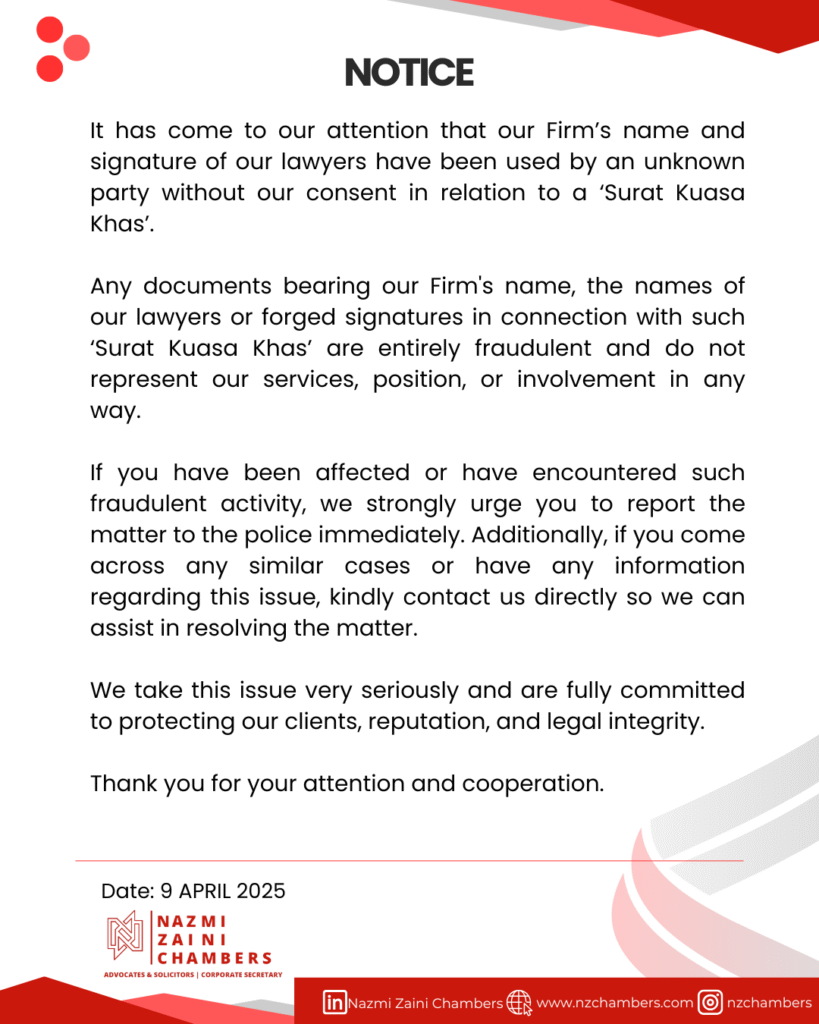“By time. Indeed, mankind is in loss.”
(Quran 103:1-2)
Time governs everything—relationships, obligations, and, crucially, legal rights. In contractual dealings, time is not merely a formality; it dictates the enforceability of rights and obligations. It determines when performance is due, when a breach occurs, and when a claim can be pursued. When a contract specifies a timeline for performance, adherence is not optional. In the absence of a specific timeline, the law implies a reasonable period, but even this is not indefinite. Time waits for no man, and the law does not favor those who sit on their rights.
Beyond contracts, time is equally significant in litigation. The Limitation Act 1953 prescribes time limits for legal actions: claims founded on contract and tort must be brought within six (6) years[1], while actions involving land recovery extend to twelve (12) years[2]. These limitations are not procedural technicalities but substantive barriers to justice—failure to act within the stipulated timeframe extinguishes the right itself.
Against this backdrop, we examine the Court of Appeal decision in Yeng Chong Realty Bhd v Edward Stanislaus De Silva & Ors [2024] MLJU 2995, a case that underscores the pivotal role of time in contractual disputes and statutory limitations.
The Facts
In 1999, the Defendant, the registered owner of eight plots of land in Mukim Ayer Panas, Melaka, launched the Bandar Golden Valley Golf Resort project, promoting it as a prime residential development. The Plaintiffs, enticed by advertisements promising exclusive bungalow plots, entered into Sale and Purchase Agreements (SPAs) between April 1999 and April 2000.
The SPAs contained two critical clauses: (1) Clause 25: Time is of the essence and (2) Clause 16(1): Required the Defendant to deliver vacant possession within 36 months, meaning deadlines fell between April 2002 and April 2003.
However, the promised land remained elusive. Despite repeated demands, the Defendant failed to deliver vacant possession. Over the years, the Plaintiffs waited, some continuing to make payments. Finally, on 05.08.2020, the Plaintiffs initiated legal proceedings, alleging continuous breach of contract, fraudulent breach of trust and unjust enrichment.
The key question before the Court was this: When did the Plaintiffs’ cause of action arise? This issue would determine whether their claim was still valid or time-barred under the Limitation Act.
The First Clear and Unequivocal Threat
The law is well-settled: a cause of action arises when a party has the legal right to sue. But how does one determine this? The courts have consistently ruled that time starts running from the first clear and unequivocal threat to the plaintiff’s right.
The Court of Appeal referenced the Federal Court ruling in Nasri v Mesah [1971] 1 MLJ 32, where Gill FJ explained:
“This expression, ‘cause of action’, has been repeatedly the subject of decision, and it has been held, particularly in Hemp v Garland LR 4 QB 509 511, decided in 1843, that the cause of action arises at the time when the debt could first have been recovered by action. The right to bring an action may arise on various events; but it has always been held that the statute runs from the earliest time at which an action could be brought.”
In Board of Trade v Cayzer, Irvine & Co [1927] AC 610 617. Viscount Dunedin described “cause of action” as that which makes action possible. Now, what makes possible an action founded on a contract is its breach. In other words, a cause of action founded on a contract accrues on the date of its breach. Similarly, the right to sue on a contract accrues on its breach. In the case of actions founded on contract, therefore, time runs from breach (per Field J. in Gibbs v Guild 8 QBD 296 302). In the case of actions founded on any other right, time runs from the date on which that right is infringed or there is a threat of its infringement (see Bolo’s case LR 571 A 74). It would seem clear, therefore, that the expressions “the right to sue accrues”, “the cause of action accrues” and “the right of action accrues” mean one and the same thing when one speaks of the time from which the period of limitation as prescribed by law should run.
For the reasons I have stated, the period of limitation in the present case can be said to have begun to run only from the first clear and unequivocal threat to the plaintiff’s right to a transfer of the land…”
Applying this principle, the Court of Appeal had to determine: Did the Plaintiffs’ cause of action arise when the Defendant failed to deliver vacant possession in 2002-2003, or much later?
The High Court’s Findings
The High Court ruled in favor of the Plaintiffs. It held that the first clear and unequivocal threat to their rights only occurred on 7 October 2020, when the Defendant filed an application for leave to enter appearance and submit its defence. The High Court considered several factors including there was no explicit refusal to deliver vacant possession, the Defendant continue to accept payments and no response to some of the Plaintiffs’ demands. Since there was no clear refusal until 2020, the High Court concluded that the limitation period had not expired and allowed the Plaintiffs’ claims to proceed.
The Court of Appeal’s Decision
The Defendant appealed to the Court of Appeal. It held that the first clear and unequivocal threat arose the moment the Defendant breached Clause 16(1)—when vacant possession was not delivered within 36 months.
Key Findings:
- Breach Occurred in 2002-2003 – The SPAs were explicit: time was of the essence. The Defendant’s failure to hand over vacant possession within 36 months was a definitive breach.
- Legal Rights Arose by 2014-2015 – The Plaintiffs’ right to sue was clear by 2014-2015. They could have claimed liquidated damages, terminated the contract, or sought specific performance.
- The Limitation Period Had Expired – By the time the Plaintiffs sued in 2020, the twelve-year limitation period under the Limitation Act 1953 had long expired.
Apart from that, as the High Court made its finding that issue on fraudulent breach of trust and unjust enrichment was not proven on the balance of probability and it was not appealed to the Court of Appeal, the finding stand as it is. Thus, the Plaintiffs’ claims were time-barred. The appeal was allowed, and the Plaintiffs’ claims were dismissed.
The Court of Appeal also made further findings that however unfortunate the Plaintiffs are, the Court cannot override the provisions of the Limitation Act 1953 and there is no room for general judicial discretion outside the Limitation Act as held by the Federal Court in Majlis Peguam & Anor v Tan Sri Dato’ Mohamed Yusoff Mohamed [1997] 2 MLJ 271.
Comment
The statutory limitation exists to provide certainty and to avoid claimants to sleep on their rights. Action to enforce your legal rights are not eternal; they must be enforced within the prescribed period. Whether drafting contracts, managing disputes, or pursuing claims, awareness of time limits is key to protecting legal interests.
Authors:
- Azrul Haziq Khirullah
- Wan Tasnima
References:
[1] Section 6(1)(a) of Limitation Act 1953
[2] Section 9(1) of Limitation Act 1953






